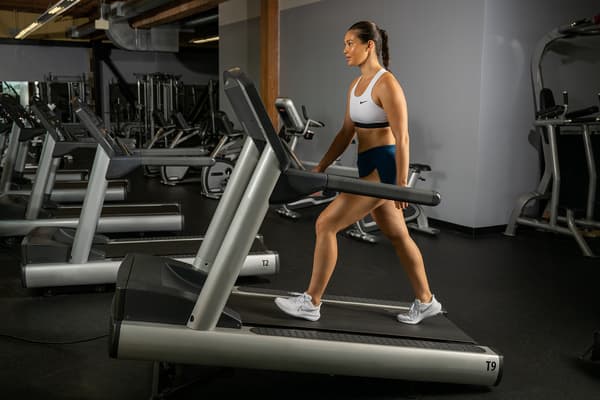What Is Power Walking—And Do You Need to Add It to Your Weekly Workouts?
Sport & Activity
Both research and experts indicate that walking at a fast pace can lead to some impressive health benefits.

While walking is a low-maintenance and effective form of exercise, power walking ramps up this basic movement to the next level.
"Power walking is walking at a rapid speed with arms pumping, moving in a heel-to-toe step", said Gretchen Zelek, AFAA-certified group fitness instructor and FIA-certified functional ageing specialist. "While normal walking is considered a lower-body activity, power walking is a full-body cardio workout that also engages the core".
She said that power walking tends to be faster than normal walking, but slower than running. For reference, power walking typically averages around 4–5mph.
By doing so, you'll also be working towards achieving important weekly exercise goals for your health. According to the Centers for Disease Control and Prevention (CDC), walking briskly at a pace of at least 3mph qualifies as a moderate-intensity aerobic activity, which it recommends doing for at least 150 minutes per week.
If you're new to power walking and searching for your optimal pace, consider how your body moves at different speeds.
"Unlike a run or jog, at least one foot must always stay in contact with the ground in a power walk", said Marissa Miller, an ACE-certified personal trainer. "This, in part, makes power walking a low-impact and knee-friendly alternative to running".
Also, power walking involves becoming more observant of your steps and stride length.
"Power walking aims to tackle more ground in the same amount of time—or the same [distance] in less time", said Miller. "This means you can choose to take steps quicker or bigger steps—whichever works according to your fitness level".
The simplest way to know if you're power walking is by monitoring your heart rate. The CDC states that for moderate-intensity aerobic activity, your heart rate should be between 64 percent and 76 percent of your maximum heart rate, which can be estimated by your age.
In order to find your estimated maximum number of beats per minute, subtract your age from 220. For example, the average 40-year-old's maximum age-related heart rate would be 180 beats per minute. Therefore, that person's target heart rate range for a moderate-intensity aerobic activity would be between 115 and 136 beats per minute.
Proper Power-Walking Techniques
Before heading out for your walk, Miller said to spend a few minutes warming up your muscles.
"Power walking is a lot more taxing on your body than a typical walk, so start by stretching out your calves, groin, spine (meaning spinal extensors) and glutes to help keep them limber, increase your range of motion and avoid injury", she said.
RELATED: The 7 Best Stretches for Shin Splints
As you take your first step, begin by leading with the heel and then pushing off from the toes when taking the next step with the other foot. Zeleck said that one foot should remain in contact with the ground at all times.
Make sure you keep your head up with your chin parallel to the ground. "Hold your arms at 90 degrees, lightly brushing your side while pumping them up and back as you walk with a relaxed, closed fist", Zeleck said.
Also, engaging your core will encourage good posture, Miller said. "A curve in your back and shoulders will not only tilt your pelvis forwards leading to an inefficient stride, it can also lead to long-term imbalances", she said.
The goal is to walk with the pelvis in a neutral position (where the hips are neither tipping forwards or backwards). A curve in your back and shoulders will tilt your pelvis forwards, also known as an anterior pelvic tilt, which can cause hip, knee and lower back pain. But tucking your tailbone too far back – a posterior pelvic tilt – may cause sciatica. Both incorrect positions can lead to inefficient strides and long-term imbalances.
Now check out some of the top benefits of doing a power-walking workout.
4 Health Benefits of Power Walking
1.Power Walking Can Improve Balance
"Studies have been conducted to look at the effect brisk walking has on postural stability or the ability to maintain or restore a sense of balance. According to research published in a 2016 issue of the journal BMC Women's Health, brisk walking maintained postural stability when the participants' eyes were closed—a result that can have a direct effect on reducing the risk of falls under worse spatial orientation and visibility.
The study tracked 104 women over the age of 50 with a sedentary job. The researchers directed the women to wear a fitness tracker. The participants were then asked to power walk to or from work for a total of 30–35 minutes at least five times per week. At the end of the 10-week trial, the investigators tested the females' postural stability by having them perform 30-second exercises on a special measuring platform with sensors with their eyes open and closed.
According to their findings, brisk walking maintained postural stability when the participants' eyes were closed—a result that can have a direct effect on reducing the risk of falls under worse spatial orientation and visibility.
2.Power Walking May Improve Digestion
An observational one-week study published in a 2020 issue of the journal PLoS One found a possible link between daily walking and a better-functioning gastrointestinal system amongst females.
Scientists from Japan gathered 101 young university students who were dealing with (but not taking medication for) mild cases of irritable bowel syndrome, or IBS, and instructed them to wear a pedometer for seven days while tracking their symptoms. Female participants reported significantly lower discomfort, even as they logged more steps.
In fact, it was estimated that walking 9,500 steps a day could lead to a 50 percent reduction in IBS discomfort compared with walking 4,000 daily steps. The authors theorise that walking after eating can stimulate the stomach and intestines, helping to move food through the system at a quicker pace. They also believe that results were only noticed in the women because there were gender differences when it came to symptoms—females were more likely to suffer from bloating and constipation, while males were more likely to deal with diarrhoea.
3.Power Walking Can Lower Blood Pressure
According to a 2018 study published in PeerJ, walking on a regular basis can be beneficial for adults with hypertension or high blood pressure. The study was conducted over a six-month period, during which nearly 300 sedentary men and women were divided into groups (based on their average speed) and given a fluctuating walking workout schedule. The routine started out at a moderate rate (15 to 30 minutes a day) and increased over time (50- to 70-minute sessions at various paces five days a week).
The researchers found a reduction in systolic blood pressure (the pressure caused by the heart contracting and pushing out blood) among all of the adults. The largest reductions were seen in those who began the trial with higher blood pressure readings. Furthermore, an increase in walking speed led to a decrease in other risk factors of cardiovascular disease, including a reduction in body weight and waist circumference.
"Power walking is a stellar form of cardiovascular exercise, which strengthens the heart muscle", Miller said. "A stronger heart pumps blood more efficiently with less effort, leading to less pressure build-up in the arteries".
Don't miss 7 Cardio Exercises That Aren't Running!
4.Power Walking May Add More Years to Your Life
Brisk walkers tend to have a longer life expectancy, according to a 10-year study published in a 2019 issue of Mayo Clinic Proceedings.
Researchers in the United Kingdom examined the data of more than 474,900 adults (with an average age of 52), which included the volunteers' walking pace, body mass index, waist circumference and body fat percentage. Regardless of their weight, the adults who regularly power walked (at a pace of more than 4mph) were likely to live an estimated 13–24 years more than those who walked slower than 3mph.
Since this was an observational study, the researchers noted that walking pace was simply an indicator of longevity. Regardless of power walking speed, this research suggests that it's generally a good form of exercise, can boost physical fitness and perhaps even tack on a few extra years. Not to mention that it's lower impact than other forms of cardio, such as running, skipping and cross training.
The Bottom Line
Power walking on a regular basis may result in better balance, lower blood pressure, improved digestion and, potentially, a longer lifespan. Consider giving it a go—if your doctor says it's a fit for you.
Words by Amy Capetta





